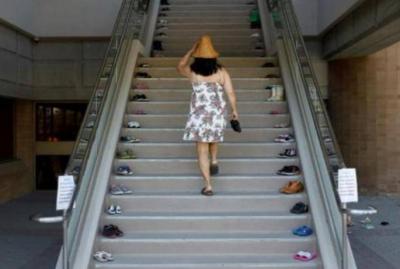Stephanie Gutiérrez placed 215 pairs of children's shoes in front of the Kamloops court on Wednesday, with tears in her eyes, as a symbolic gesture following the discovery of the remains of numerous students from a former residential school in the Canadian city, established over a century ago to assimilate Indigenous people. She stated, "I am here to advocate for my people," holding a photo of her deceased grandmother, who was forcibly detained for three years at this residential school.
Since the discovery of the remains of the 215 children, community members have been visiting the memorial set up at the site to leave messages of support, toys, and children's shoes. She told AFP, "I am here today to speak for my people, my grandmother, and everyone who cannot raise their voice, because it is an unimaginable tragedy. Unthinkable things happened here, in this school."
She continued, "I lost 215 descendants; they were kidnapped. These children were taken from their families, tortured, and then killed." Stephanie added, "I want Canada to understand and for people to realize where this pain comes from. This pain originates from this school, from the people who mistreated these children. They did many tragic things to them... 215 children died here, and there may be more."
Kamloops was the largest of 139 residential schools established in the late 19th century, accommodating 500 students. The Truth and Reconciliation Commission identified or disclosed information about at least 3,200 children who died due to mistreatment or neglect while attending residential schools, but the exact number remains unknown. The Catholic Church managed the school on behalf of the Canadian government from 1890 to 1969, and it was permanently closed in 1977. The operation of other residential schools, totaling approximately 140, continued until the end of the 20th century throughout Canada.
Canadian Minister of Indigenous Services Marc Miller stated on Tuesday that the failure to apologize from the Pope and the Catholic Church for their role in managing the residential schools in Canada "is shameful." When asked whether he supported calls for a papal apology, the minister responded during a press conference, "Of course." He clarified, "The Church was undoubtedly wrong in implementing the colonial government's policy that was devastating to children, families, and communities."
The Catholic Church and the Canadian government maintained that they aimed to "civilize Indigenous children" by instilling Western values in them, separating them from their communities and placing them in these residential schools, where many experienced physical and sexual abuse. Thousands of them died or went missing, according to a report by a commission of inquiry.
The discovery of the children's remains has sparked outrage among Indigenous communities, despite efforts by successive Canadian governments to reconcile with them.
Stephanie expressed that this discovery, which some local communities have questioned but experts confirmed using geological radar, "sparked a lot of emotions." She noted that she was shocked by the fact that many grieving Indigenous people did not want to talk about it. She explained, "I feel I have enough strength to be here for those who cannot speak, and that’s why I am here, to tell people what is happening... We will go to the courtroom with 215 shoes to show that we want justice for these children."
Before the court, flags were at half-mast. Stephanie, wearing an orange shirt that read "Every Child Matters," displayed dozens of children's shoes online. Bernadette Mack, a member of the Nuxalk Indigenous community, came to support her. She stated, "I think it is important to raise awareness and educate people about the residential schools."
She added that she was very excited to see all these pairs of shoes, each representing the life of a child lost in the residential school system designated for Indigenous peoples, but she hopes that this event will help people understand the reality of what happened. She concluded, "Although it is sad, it is good for people to understand what happened."




